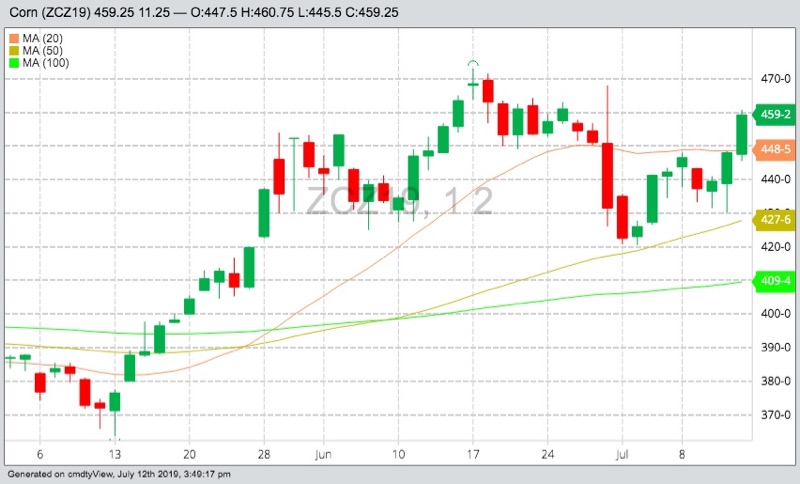Chicago | Reuters — U.S. corn futures hit a six-week high on Wednesday on forecasts for rains in the Midwest crop belt that could signal further planting delays, but the market pared gains as the run-up in prices triggered a round of farmer selling, traders said.
Wheat futures also ended nearly flat while soybeans closed higher.
Chicago Board of Trade July corn settled up 3/4 cent at $3.69-1/2 per bushel, after reaching $3.80 a bushel in midday trading, the contract’s highest since March 29 (all figures US$).
Read Also

Alberta crop conditions improve: report
Varied precipitation and warm temperatures were generally beneficial for crop development across Alberta during the week ended July 8, according to the latest provincial crop report released July 11.
Corn firmed on forecasts for rains to return to the U.S. Corn Belt this weekend and persist next week.
But the rally stalled as the July contract reached $3.80 and the new-crop December contract approached $4 a bushel, high enough to entice farmers to sell.
“This is a classic transfer of risk, where funds were covering their short positions and the farmer was happy to sell to them,” said Terry Linn, an analyst with Linn + Associates, a Chicago brokerage.
CBOT July soybeans settled up four cents at $8.35-1/2 per bushel, after rising to $8.48-1/4 in midday trading.
CBOT July soft red winter wheat ended up 1/4 cent at $4.48-3/4 per bushel, while K.C. July hard red winter wheat fell 6-3/4 cents to $4.02 a bushel and Minneapolis Grain Exchange July spring wheat closed down eight cents at $5.15-1/4 a bushel.
Corn futures have risen sharply this week, with the July corn contract surging 37 cents from a contract low of $3.43 on Monday to Wednesday’s high of $3.80, as U.S. planting worries prompted funds to unwind a portion of their massive net short position.
“We’re a little bit over-extended on some big short-covering. But if the (weather) forecast verifies, there is going to be some significant acreage loss,” said Dan Cekander, president of DC Analysis.
“There is some planting going on, but it looks like a pretty limited window,” Cekander said.
U.S. farmers seeded 30 per cent of the U.S. 2019 corn crop by Sunday, the government said, lagging the five-year average of 66 per cent. The soybean crop was nine per cent planted, behind the five-year average of 29 per cent.
CBOT soybeans extended their rally from Tuesday, after U.S. President Donald Trump eased concerns over the U.S.-China tariff war.
But bearish monthly soy crushing data hung over the market, capping gains. The National Oilseed Processors Association said its U.S. members crushed 159.99 million bushels of soybeans in April, down from 170 million in March and below an average of analyst expectations for 161.6 million.
Also, China’s sow herd fell by 22.3 per cent in April from a year earlier, the ministry of agriculture and rural affairs said, underscoring the effects of an epidemic of incurable African swine fever.
The decrease in China’s hog herd, the world’s largest, suggests a drop in demand for soy-based animal feed.
Wheat drew support from news that drought-hit Australia will import its first shipment of wheat in more than a decade, from Canada.
— Julie Ingwersen is a Reuters commodities correspondent in Chicago; additional reporting by Sybille de La Hamaide in Paris and Naveen Thukral in Singapore.

















